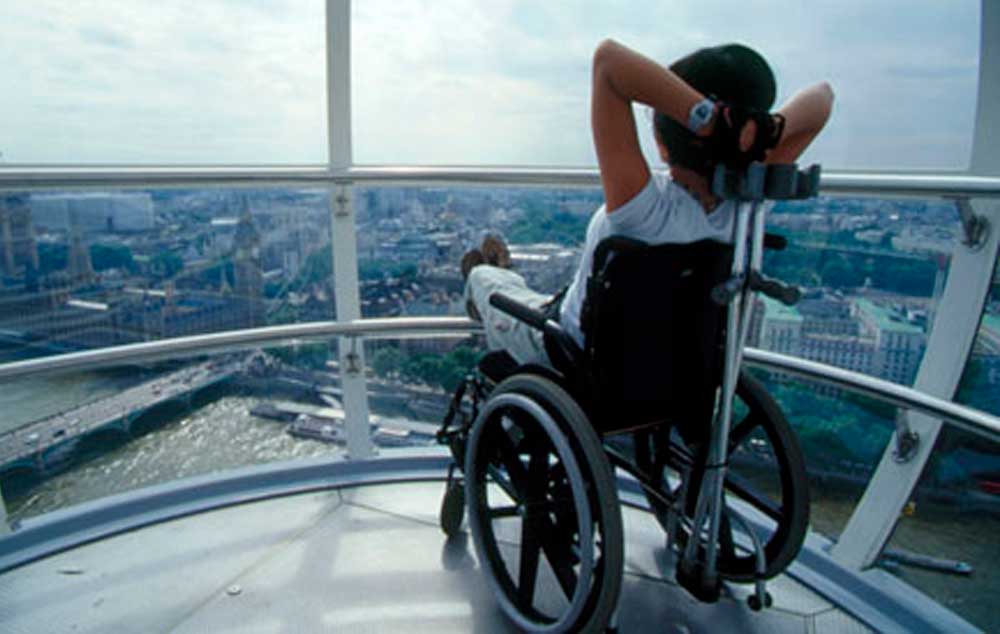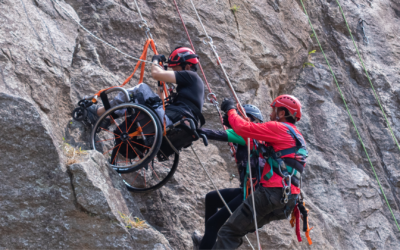
Paralympic Games 2012: Top 10 accessible days out in London
The Paralympic Games are almost upon us as London gets set to welcome disabled visitors from all over the globe. London has so many attractions offering a great inclusive experience, but I’ve selected some of my personal favourites. You’ll need to do a bit of research to satisfy yourself the venues offer exactly what you need, so check websites before you go. Sites with films, photos and audio-description are particularly helpful and it’s good to cross-reference with disability specialists such as Tourism for All. A call ahead of your visit is a good idea just in case a particular feature is unavailable for some reason. While some attractions are free, those that charge usually offer concessions to disabled people or their carers. The best thing about London is there is something for everyone:
London Eye and South Bank
The London Eye on the South Bank provides a breathtaking introduction to London with its stunning bird’s-eye views. Book ahead for disabled tickets and avoid the queues at the same time. My wife was relieved to discover the wheel can slow or stop to allow people with disabilities to board, and you can get two wheelchairs in a capsule. The South Bank, London’s riverside cultural centre, is a great area to explore with theatre, film, music and exhibitions in iconic venues, street entertainment on busy days and loads of places to eat.
• londoneye.com
Tate Modern
A perfect day out with loads to see and do to engage all tastes and ages. All exhibits are accessible to wheelchair users and people with impaired mobility. There are lifts to all floors although they tend to be quite packed, so you sometimes have a bit of a wait. The Turbine Hall is particularly good fun if you use a wheelchair! Call ahead to reserve a disabled parking space, or if you’re feeling adventurous and the weather is looking good why not try combining a visit with a boat ride? Boats stop at nearby Bankside Pier but not all are accessible – check first with the Transport for London website. Alternatively the Tate Boat runs between Tate Modern and Tate Britain and can accommodate wheelchairs, but not mobility scooters.
• tate.org.uk/visit/tate-modern, free except for special exhibitions
Camden Town
If you like the idea of seeing the other side of London then a visit to Camden at the weekends is a must. It’s the perfect place for people watching, the atmosphere is buzzing and the street food is fantastic. Although the market is generally accessible, with lifts to the upper levels, wheelchair users beware as the ground is uneven and cobbled in many places, especially round the Lock. It does get crowded, so be prepared for a bit of pushing and shoving as people tend to be looking around rather than being aware of others. And check out the legendary and now extremely accessible Roundhouse, just up the road from the northern end of the market – even if you don’t see a show (with an infra-red assisted hearing system, some performances audio-described), it’s a great place to meet up for a drink or a bite to eat and use the disabled loo.
Science and Natural History Museums
If it looks like the weather is not on your side, then a trip to Exhibition Road could provide the answer, particularly if you’ve got children in tow. Both museums have thought long and hard about inclusivity and there are many special events and features for people with differing needs. Check out the SIGNtific events (deaf-led family events with voice-over interpreters) and the ultra-slick wheelchairs on loan at the Science Museum. Some of the simulators are down steps but the majority of interactive displays and all exhibits are very accessible. The long halls in the Natural History Museum are fun to navigate on wheels and let’s face it, who doesn’t like a dinosaur?
• sciencemuseum.org.uk, free entry except Imax cinema, flight simulators and special exhibitions; nhm.ac.uk, free except for special exhibitions
Royal Botanic Gardens, Kew
Why not take a trip out to West London with a picnic and spend the day in Kew Gardens? It’s a beautiful location set in 300 acres with plenty to see and do. The famous steamy Victorian Palm House is well worth a visit (although no wheelchair access to the upper gallery) as is the fabulous Xstrata Treetop Walkway, which I rather unexpectedly discovered is accessible via a lift. Kew offers a range of services for disabled visitors; wheelchairs and mobility scooters are available to hire and the Explorer bus makes life a whole lot easier.
• kew.org, adults £16, concessions £14, registered blind/partially sighted visitors and essential carers free
London Zoo
Lots to see, lots to do at this ever-evolving zoo. Given the age of the place and historic buildings, this is a surprisingly accessible day out. Check out feeding time at the new Penguin Beach with spaces set aside for wheelchair users. My family are particularly keen on the Rainforest Life exhibit and the gorillas, and kids love exploring the underground world in the Animal Adventure children’s zoo. Although mostly very accessible watch out for some of the ramps which are quite steep, particularly down to the tunnels. Wheelchairs are available to hire, but book in advance.
• zsl.org/zsl-london-zoo, adults £23, concessions £21
Shakespeare’s Globe
If you’re after a slice of historical entertainment then book a performance at the Globe. Step back in time and experience the show as a “groundling” did more than 400 years ago getting close to the action right next to the stage. If the weather’s looking dodgy, a space in the seats may be a better option and the wheelchair platform has great views. Follow it up with a tour or a visit to the exhibition which has been well thought through with features for sight and hearing impaired visitors available throughout. Top tip for drivers – book ahead and see if you can get one of the disabled parking bays.
• shakespearesglobe.com
British Museum
From the Aztecs and the Incas, to the history of the world in 100 objects, the British Museum has it all. It doesn’t matter how many times you visit, there’s always more to discover. Marvel at the extraordinary Rosetta Stone then go for a coffee in the Great Court to contemplate. As for my six-year old, she can’t get enough of the mummies. The museum has excellent access provision for anyone with mobility issues. It also has touch tours and tailored exhibit handling sessions if you book far enough in advance.
• britishmuseum.org, free
Victoria and Albert Museum
If you’re into the history of art, fashion and design, then no trip to London would be complete without a visit to the V&A, which has a collection spanning thousands of years. Although an old Grade 1 listed building it has been refurbished in recent years, making it as inclusive as possible. Perhaps the most impressive feature is the monthly curator-led Touch Tour – visually impaired visitors are invited to handle objects while curators trained in audio description techniques provide expert commentary.
• vam.ac.uk, free except for special exhibitions
London Wetland Centre
If you feel like escaping the buzz of town for a while and getting some fresh air, head out to Barnes in the south-west, and pay a visit to the Wildfowl and Wetland Trust’s nature reserve. It’s an oasis of calm where you can spot birds and wildlife, or simply wander around the marshes and lakes on the accessible tarmac or compacted gravel pathways. Most of the bird hides have level access, with a lift up the Peacock Tower hide. Free parking and wheelchair loan, including a scooter which must be booked in advance.
• wwt.org.uk/visit/london, adult £10.99 (with gift aid), essential carers free
Getting around
Sadly, London has never been the easiest place to navigate particularly for those with mobility issues. Much though has been done in recent years ahead of the Paralympics to improve the accessibility of public transport, with wheelchair-accessible buses and black cabs, but most underground stations don’t have lifts. So when you know where you want to go, plan ahead and allow extra time for those taxis who for some reason don’t see you, or buses that are too full of buggies to fit a wheelchair passenger on. For detailed info check Transport for London’s site.
You may prefer to drive but parking provision is patchy and Blue Badge rules don’t necessarily apply. Rather unhelpfully, The City of London, Westminster, Kensington & Chelsea and some of Camden have adopted their own disabled parking policies.
• Londoner Andy Gilbert is a Paralympic Games swimming medallist and studio director for Channel 4’s forthcoming Paralympic coverage. He recently launched Gilbey Films, a production company specialising in showcasing disability access.
Source: The Guardian
Compartilhe
Use os ícones flutuantes na borda lateral esquerda desta página
Siga-nos!
Envolva-se em nosso conteúdo, seus comentários são bem-vindos!
Artigos relacionados
Teleton AACD. A pessoa com deficiência como protagonista.
Teleton AACD. A pessoa com deficiência como protagonista. Uma iniciativa internacional abraçada pelo SBT no Brasil.
Acessibilidade no ESG. Equipotel aborda o tema para o turismo.
Acessibilidade no ESG, para o mercado do turismo. Equipotel aborda a importância da inclusão da pessoa com deficiência.
Morte Sobre Rodas. Filme inclusivo foi candidato ao Oscar.
Morte Sobre Rodas. Dois protagonistas do filme, são pessoas com deficiência, um usuário de cadeira de rodas e outro com paralisia cerebral.






0 comentários